Dimming switch for LED bulb
Since the advent of electric lighting, engineers have tried to solve the problem of regulating the brightness of lamps. In the early days of electrical engineering, only two methods were available - rheostats and adjustable transformers. These devices are cumbersome and inconvenient to use in the home, they have other disadvantages. Therefore, only with the development of solid-state power electronics and the development of powerful but compact electronic switches, modern devices called dimmers were created.
What is dimming and how it works
Dimmer is the regulation of the brightness of lamps of various designs from the maximum to the reduction. The term comes from the English verb to dim. Light regulators are used to create comfortable lighting, as well as to create different lighting effects (modern devices, controlled by controllers, are used for this purpose).
The task of reducing the brightness of the glow was solved in different ways at different stages of the development of electrical engineering. Initially, curtains were used for this purpose, which could partially block the luminous flux. Then the developers have come a long way from potentiometers and adjustable transformers to modern compact devices. They are based on a power switch that cuts out part of the sinusoidal waveform supplied to the luminaire.
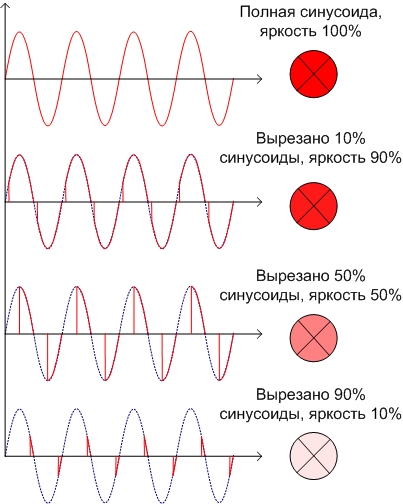
At a certain point after the sine passes through zero, the key opens. The later the opening, the less time the load is energized, the lower the average current. Consequently, the average brightness of the light is also lower.

In this circuit a triac serves as a key, and a potentiometer regulates the opening torque. Such a device is suitable for regulating the glow of incandescent lamps и halogen bulbs. LED devices have their own specifics.
What bulbs can be used with a dimmer
Although the basis of the glow of incandescent lamps and LEDs are different principles, they have in common - the intensity of the glow depends on the average current flowing through the element. The problem with dimming most LED lights is that they are not plugged into the network directly, but through a current regulator (driver). Its task is to maintain the brightness of the glow regardless of changes in the parameters of the supply voltage. In other words, such a device is designed to resist the processes that accompany dimming. Therefore, it is impossible to regulate the intensity of luminescence with conventional devices.
There are special lamps, the input circuits of which drivers are supplemented by a special circuit. It monitors the average voltage value at the input and in accordance with it changes the LED current, adjusting the luminous flux. Such bulbs are labeled with the word Dimmable or a corresponding pictogram.
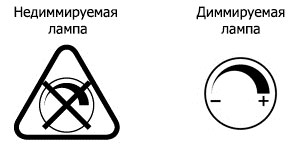
Such lighting fixtures cost more, but the possibility of their use is wider.
There are inexpensive LED lights, in which the driver in the form of an electronic circuit is absent, its role is performed by a quenching resistor. resistor. Such lamps are undesirable to include directly into the AC network, even if they pass the parameters. They are not designed for the high reverse voltage applied during the negative half-cycle. This can cause them to fail quickly. Therefore, they should be plugged into any AC voltage through a rectifier (preferably a double half-period) or used at DC voltage. In the first case, they are dimmed in the usual way, but they must be switched in the "dimmer - rectifier - lamp" circuit. In the second case, it is necessary to use special dimmers that control glow by pulse-width modulation. Such devices are usually made on the basis of controllers and control options are limited only by the imagination of the developers.
For convenience, to assess the compatibility of lamps and dimmers for LEDs, the data are summarized in the table.
Type of dimmer | Lamp type | ||
| Dimmable with driver | Dimmable with a special driver | LED strip or lamp with a dimmer resistor | |
| Conventional | Incompatible | Compatible | Compatible when using a rectifier |
| LED with DC output | Incompatible | Incompatible | Compatible |
Important! All LED strips belong to the class of dimmable LED strips - LED strips that are not dimmable do not exist in principle. Labels Dimmable on such devices - pure marketing gimmick.
LED brightness control at a constant voltage
If the LED light operates on constant voltage, its brightness can also be adjusted. The simplest way is to switch in series in series with the LED is a variable resistor. Changing its resistance changes the current in the circuit.
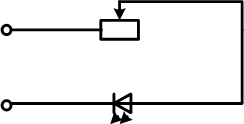
This method has long been recognized as unsuccessful because of energy inefficiency. A lot of power is needlessly dissipated in the resistor. It is much more rational to distribute power over time. In this case, the key is periodically closed to reduce the intensity of the glow, and the light level is averaged through the inertia of human vision.
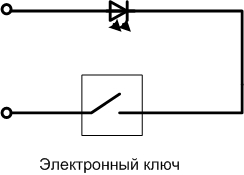
In practice, this is done by PWM. The LED is fed by rectangular pulses of constant amplitude and frequency, but of different durations.
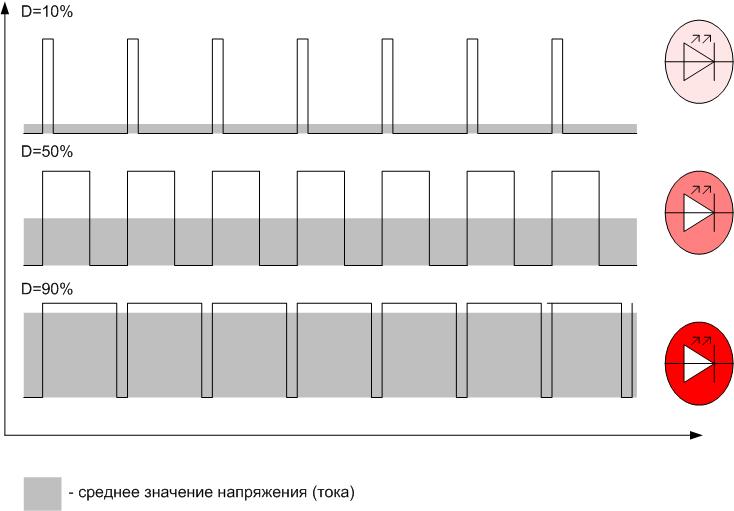
Depending on the pulse length, the average current through the LED changes, which the human eye perceives as a change in brightness.
Modulation by pulse width is easy to implement with the help of processor technology. Therefore, various devices for creating lighting effects are made on controllers.
Advantages and disadvantages
The pluses of the ability to adjust the level of illumination include:
- obtaining a comfortable illumination of the room;
- saving electricity;
- the ability to emphasize details (in the case of decorative lighting);
- Reducing heat generated by the luminaires;
- the possibility of remote and automatic control;
- prolongation of LED lifetime.
Another advantage of LED lights is that in the process of changing the brightness does not change color temperature.
The disadvantages include noticeable flicker LED-emitters at low brightness levels. This leads to increased eye fatigue, as well as a harmful strobe effect. It is problematic to get rid of flicker with DC power, and impossible with AC power.. Another problem is that once a certain type of dimmer is installed, it is no longer possible to install lamps of any kind. They must be compatible with the dimmer.
Do dimmers save energy
This simple question causes a heated debate on the Internet. In fact, much depends on the design of the dimmer. Older dimmers, made in the form of potentiometers or adjustable transformers, did not provide any savings. All the power saved was uselessly dissipated at the ballast. Nowadays, almost no such devices are produced.
Dimmers based on electronic switches distribute power over time. To reduce the brightness, they close the control element completely for a given period of time, the current through the load and the switch is almost absent. Everything happens during one half-period of sinusoidal voltage, so the human eye does not notice such interference. The reduction in consumption with this method is obvious, but it's not all that simple:
- Lighting's contribution to the total power consumption of a home or office is not that great; much more is consumed by high-powered appliances. So a small reduction in energy consumption by dimming will be noticeable, but not dramatic.. Due to the global transition to LED lighting, the proportion of lighting costs is reduced even more, and the effect of dimming becomes even less.
- The dimmer itself for LED lamps has a different efficiency than 100%. With good devices this figure exceeds 90%, but it is still a waste of electricity.
- The cost of dimming devices is higher than that of conventional switches. Even with savings, they have a payback period of at least a couple of years.
- Many manufacturers, for marketing purposes, overestimate the economic effect, this leads to a mismatch of expectations from the use of dimmers.
Keep in mind that reducing the average current increases the life of LEDs. This contributes positively to the overall economics of lighting operation. In any case do not expect savings of more than 10%.
Effect of dimming on luminaire life
Applying a reduced current at switch-on time is known to increase the life of incandescent lamps. LEDs are not prone to failure at the moment of switching on, but dimming also LEDs have a beneficial effect on extending the service life of LEDS. The fact is that the life of emitters depends on the average operating temperature, which, in turn, is determined by the current. The higher the heat, the faster the degradation of the light-emitting diodes, the greater the probability of complete failure.
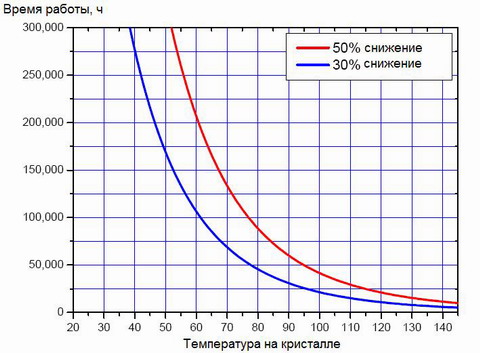
When using dimmers for LEDs, the average current becomes markedly less than the maximum, so the life of LEDs increases significantly.
To the graphs and figures in this regard should be treated with a degree of skepticism - unlikely manufacturers have arranged a complete resource test. And there is no point in them - by the end of the tests the technology will be updated, and we will have to start testing again. Therefore, the declared figures are obtained by calculation, and there is a fair amount of advertising in them.
Types of modern dimmers
A huge number of LED-emitter intensity controllers are available for sale. In addition to the differences discussed, they are also classified according to other parameters that determine the scope of the devices.
According to the type of installation
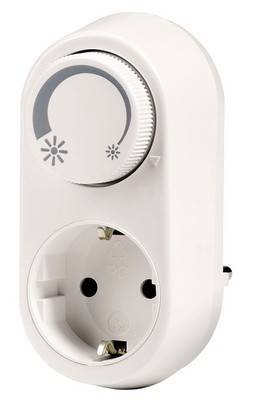
According to the type of installation devices can be:
- Wall-mounted - mounted like an ordinary light switch;
- Modular - mounted in the electrical panel on a DIN-rail;
- Suspended - are built into the structural elements of suspended luminaires;
- Portable - such a device can be plugged into any outlet and then a floor lamp or a table lamp is connected to it;
- built-in - they are hidden behind the interior elements.
The last category of devices is similar to the wall-mounted, but has a less aesthetically decorated body.
By execution
Devices can have different contact groups:
- Regular on opening-closing;
- flip-flop.
In the second case, the dimmer is called a pass-through and serves to organize a double light control scheme - from two points independently.
According to the method of regulation
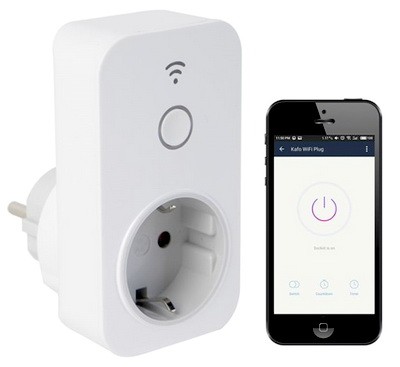
According to this criterion, the devices can be:
- rotary - the brightness is adjusted by turning the wheel, the light is completely turned off by turning it all the way to the stop;
- rotary-push-button - the brightness is adjusted by turning the wheel, the light is switched off by pressing the wheel in any position;
- push-buttons - adjustment is made by pressing the + or - buttons.
- touch-sensitive - the principle is similar to the button ones, but instead of pressing it, it is enough to touch the sensitive area;
- Remotely controlled - the light is regulated by a remote control;
- controlled via WiFi - we can control the lighting from a mobile device;
- Acoustic - controlled by a sound signal.
The last type of devices are not widespread due to low resistance to acoustic noise.
How to connect the LED-lighting via a dimmer
Led dimmer is connected to the lighting network similar to the usual switch (often it has this function as well) - in the gap of the phase wire. Therefore, it is often possible to remove the standard switch and make connect the dimmer according to the same scheme. Do not forget about the maximum power of the load that can be connected to the dimmer. It must withstand it with a margin of 15-20%. If you observe this rule, the dimmer will do its job for a long time.
Video: Connecting and adjusting the dimmer from Aliexpress.